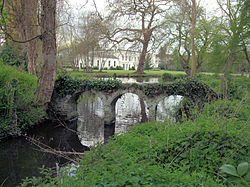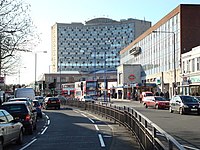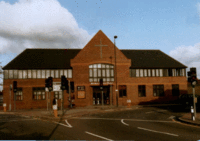Morden
| Morden | |
| Surrey | |
|---|---|
 Morden Hall Park | |
| Location | |
| Grid reference: | TQ255685 |
| Location: | 51°24’5"N, 0°11’42"W |
| Data | |
| Post town: | London, Morden |
| Postcode: | SW20, SM4 |
| Dialling code: | 020 |
| Local Government | |
| Council: | Merton |
| Parliamentary constituency: |
Wimbledon Mitcham and Morden |
Morden is town in Surrey, within the metropolitan conurbation, between Merton Park to the north, Mitcham to the east, Sutton to the south and Worcester Park to the west.
Morden appears to have its name from the Old English Mor dun "moor down".
Contents
History
Early history
Traces of the hand of man have been found in Morden from prehistory but the first significant development in Morden was the construction of the Roman road called Stane Street from Chichester to London.
The route of Stane Street through Morden follows the current A24, London Road up Stonecot Hill from the south west crossing Morden Park to the west of the current dual carriageway road and passing through the pitch and putt golf course and the grounds of St Lawrence's Church. The road then descended the other side of the hill towards the town centre passing west of the Underground station and crossing the north corner of Morden Hall Park heading in the direction of Colliers Wood and Tooting. Small Roman artefacts, mainly coins and pottery, have been found at various locations within the area although there is no evidence of any settlement.
Æthelstan the Ætheling, son of Ethelred the Unready, left "land at Mordune" to the abbey of Christ and St Peter in his will of 1015, which became the site of the first parish church of St Lawrence.
In 1086, the Domesday Book recorded the manor as Mordone, part of Wallington Hundred. It was held by Westminster Abbey and its assets were: 3 hides; 1 mill worth £2 and 7 ploughs. It rendered £15.[1] in total. Fourteen people were recorded as living in the area.
The Garth family
The manor and village remained abbey property until the Dissolution of the Monasteries in Henry VIII's reign when the manor was sold to Lionel Ducket and Edward Whitchurch. Together, they sold it on the following year to Sir Richard Garth who became Lord of the Manor.[2] The Garth family owned the land and maintained their connection with the parish for the next four centuries, living at Morden Hall Park until the manor was sold by another Sir Richard Garth in 1872.[2]
The prominence of the Garth family is recorded locally in the name of Garth Road, Lower Morden and the former Garth School.
The town today
Little of the earlier rural character of Morden survived the suburban expansion, although the area has fine provision of parks and playing fields, many of them created from remnants of the former country estates. It is, for the most part, a suburb.
The Crown public house was demolished in the early 1960s to make way for the fourteen-storey office block Crown House and a large supermarket (the supermarket was in turn demolished in the 1980s and replaced by the Civic Centre/Library). The RACS closed in 1985, and it, the cinema and the garage were all demolished in the 1980s or 1990s.
Landmarks
- St Lawrence Church, Morden
- Morden Baptist Church
- Morden Hall Park
- Morden Park
- The Bait'ul Futuh mosque, the largest mosque in Western Europe, built by the Ahmadiyya Muslim Community.
Outside links
- British Library Collect Britain archive - Mordon, Surrey, 1780
- Motco.com 15 Miles Round London (First edition), J Cary, 1786, Morden
- Odeon Cavalcade - Morden Cinema, 1960s

